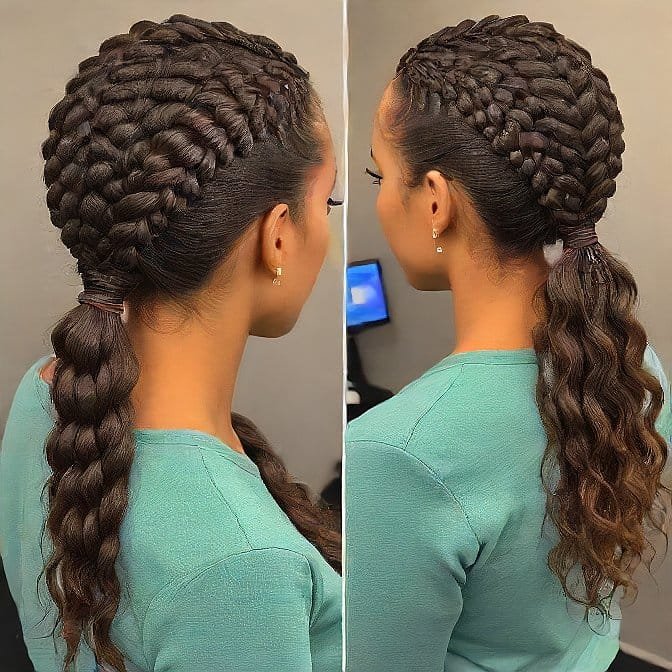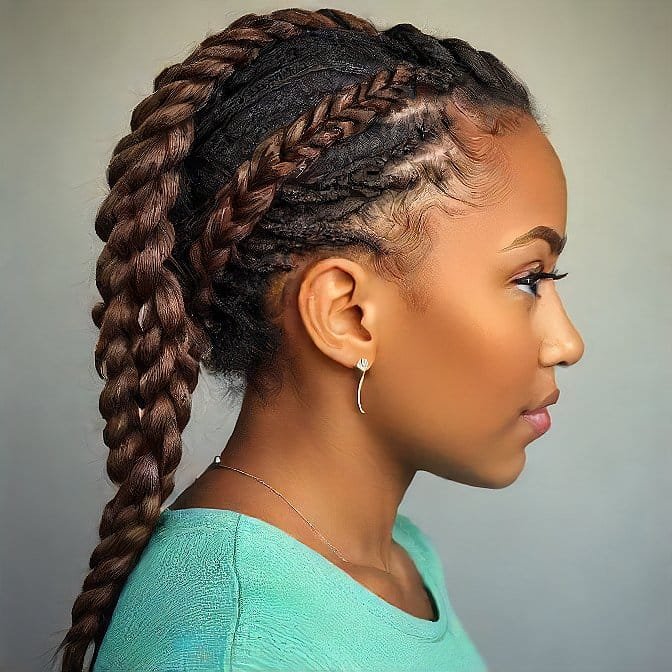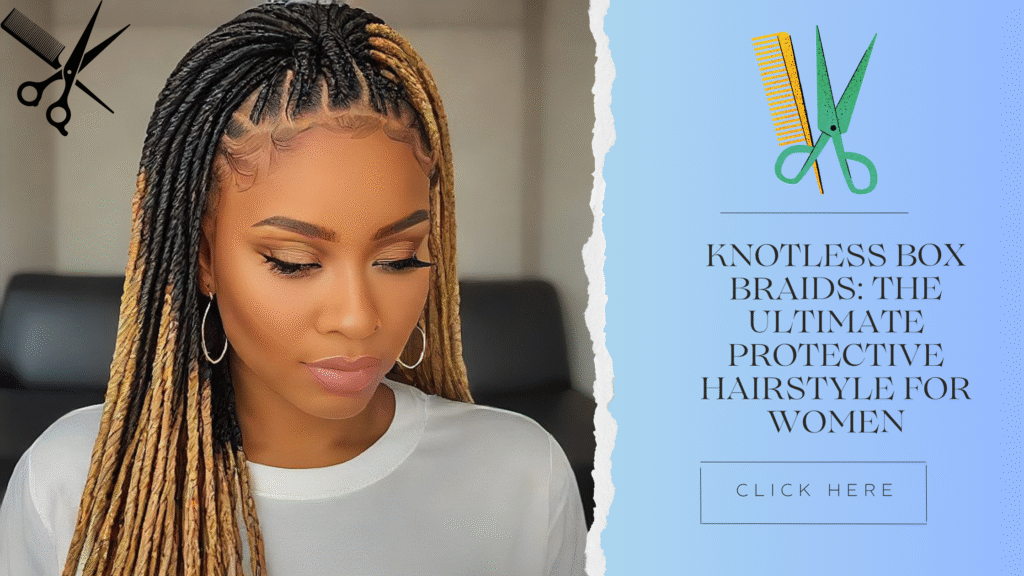Table of Contents
Introduction

Twist braids are another protective style that gives a break from constantly styling your natural hair. These braids are more fashionable and flexible to wear, ensuring that you achieve the best pull-up hairdos with a lot of ease. Twist braids can be created by two-strand twisting parts of your hair or by adding extensions. Stay tuned in order to get to know more about getting and keeping twist-braid hairdos.
Benefits of Twist Braids
Twist braids offer many great benefits:
Protection from Damage
- Contrary to relaxed hair, it is recommended that your natural hair is left to lie flat beneath the relaxed hair, so as not to be on and off, thus getting easily damaged by frequent manipulation.
- Restrict ends from the environment to eliminate any form of environmental impact.
Low Maintenance
- Can be worn for up to 8 weeks.
- Just that, use a conditioner and retwist new growing hair whenever necessary.
Healthy Growth
- The low tension on the scalp when properly installed.
- No stagnant heat or any chemical treatments.
Versatility
- Styling possibilities include dying your hair, using somebody else’s hair, or even attaching additional extensions.
- Vary in several ways; partings, size of sections, braid pattern.
How to Get Your Hair Ready for Twists
The right preparation comes in handy when getting any protective style to your hair. Here is how to set your natural hair up for success before getting twist braids:
Deep Condition Treatment
- Intensive deep conditioner treatment before twirling minimizes breakage and leaves the hair shaft’s moisture.
- Focus conditioner starting from the roots to the tips.
Clarifying Wash
- It removes any prior product, oils or any build-up present on the hair.
- Permits the braids as well as the scalp to be fresh.
Blow Dry
- Is good to make your natural hair easy to twist after you make it smooth to handle when you are holding it in your hand.
- Erases bulk and vision for a neater appearance on the completed surface.
Protein Treatment (Additional)
- Protein seals the kinks of hair, thus making the hair cuticle stronger as it refills the gaps most likely to be exploited.
- It protects hair for those who easily get their hair broken by braided hairdos
- When your hair shines, is conditioned, and prepped for protection, then it’s time to twist it up!
- Several braid designs involved are: Twist braid styles, partings, and sizes.
Style Choices
- Two-strand flat twists you only parade with your natural hair.
- Two-strand twists that have extra hair extensions/stretch recurring.
- Box Braid Hairstyles which involves the use of extension.
How to twist braids on your own hair

Doing two-strand twists on your natural hair is simple once you get the hang of the basic technique:
Sectioning
- Apply it to clean scalp or damp scalp after washing hair, or to dry hair that has been sprayed with a little water.
- Section hair into squares by using clips to keep it in place.
Begin Twisting
- Let one 1/2 inch section and split it into two strands.
- Twirl strains consequently in an anti-clockwise/clockwise direction up to the tips.
Check your parts four times
- Glide your hand with a brush along the sections you made and ensure the parts are even.
- Re-section any section that is uneven or does not appear coherent.
Smaller Ends
- After that, use your fingers and rub the ends together so they should coil into each other for small sealed endings.
Style as Desired
- Band each completed two-strand twists individually.
- Air dried, then styled into updos, knots, cuffs, or left hanging loose.
It may be somewhat tricky at the beginning, but getting into two-strand twisting your hair will make a perfect beginner’s protective style.
Check Out: Box Braid Hairstyles: Stunning Looks for Every Occasion.
Extensions for Longer Fuller Twists
To further length and thickness, you can opt for a twist braid with synthetic hair applied close to your hair type. Here’s how it works:
- Braid Base
- Extensions are first braided vertically to create a strong cord-like core for the extensions to be wound on.
- Secure Extensions
- additions are placed in and fixed at the root, with small hair braids, rubber bands, or knots.
- Begin Twisting
- When taking very small sections, start twisting synthetic and natural hair together in what is called two-strand twists.
- Twist to the End
- Proper neck manipulation should go on tightening downwards progressively from top to base in a coiled manner.
- Dip Ends(Optional)
- Some stylists will use hot water to seal twist ends, although this method is not very popular.
- Style as Desired
- This made the band, each twist individually.
- Turn parts and style twists into your favorite updo knots or hanging braids
- Added hair allows you to get giant, long twists, and you have the freedom to style as you wish.
Some Useful Tips for Twist Braid Maintenance

When you maintain your twist braid correctly, it’s possible to keep the hairstyle for 4–8 weeks. Here are some top maintenance tips:
Moisturize Often
- Apply a water-based moisturizer and sealant oil should be used 1–2 times every week
Gently Retwist New Growth
- Starting from the second or third week, when your roots emerge, twirl them again.
- broken down into small parts and reimbursement should be made into a pattern.
Protective Styling
- Put on a satin bonnet to sleep.
- Overly tight hairstyles should be altered as much as possible to lessen tension to the hair cuticle.
Avoid Too Much Heat
- Their hair is damaged if they blow dry often, so they should avoid using hot tools.
- Allow to air dry when wet.
Gently Remove
- No yanking! Spending a bit more time to make up and lose the hairstyles that incorporate twists is advisable.
- Cut off the base of the braid, don’t untwist the area roughly.
In general, it is necessary to look after braids, and prevent the hair from stretching when detangling the hairstyles.
General Problems Associated with Twist Braids
While low tension, properly done twist braids should not damage hair, some complications can occur:
Itchy Scalp
- The symptoms associated with dyed, irritated scalp.
- By using cool water, topical scalp spray, and massaging the affected area, the patient gets relieved.
Frizzy Hair
- Consequences arising out of washing or getting hair wet often and not re-twist.
- Coat it with anti-humectant oil to close the cuticles.
Tender Roots
- The threat of experiencing sensitivity along the hairline due to pulling.
- Apply topical analgesic and style differently.
Breakage
- This could happen when you put heavy braids or make the installments tighter at the roots.
- Consequently, free any braids that enhance noticeable thinning or damage promptly.
If something feels wrong, be sure to get the problematic braids out as soon as possible to avoid prolonged damage.
Styling Required on Extra Occasions
- Old twists should be removed in 1–2 weeks, if you want the hair loose and styled a certain way.
- Pay attention to when your scalp, hair, and styling preferences say it is time to take out the protective twist braid.
Conclusion
As you noticed, where professionally done and maintained, twist braids are indeed the perfect protective style as they are described. They help you maintain and grow healthy hair, since twist styles look neat without daily styling and when done in braids. Here again, there are many cool size, parting, and pattern trends that you can try out with twists as well. Boast your beauty and creativity by giving it a try in this standard protective style: braided. Your hair will thank you!
For More Info: Click Here.
FAQs
For how many days can one let twist braids in?
When twist-braided, hair can last for 4–8 weeks, and this is when hair is regularly moisturized and gently re-twisted, if necessary. Remove them at any sign of damage matting or SCI discomfort to the scalp.
Does twisting ruin your edges?
No, twists do not have to damage the hairline if done properly without pulling your scalp and putting much tension on it. However, any type of braid that is worn tightly for long will leave the edges destroyed.
What is the price of professional twist braids?
Prices are also different depending on the location, the stylist’s experience, and whether extensions are used or not. Usually, it takes $80-$250 to get professional twists.



